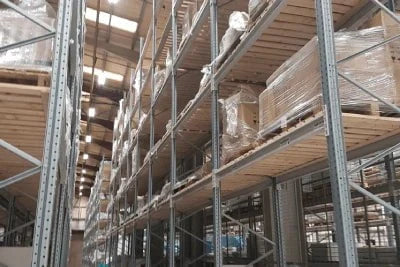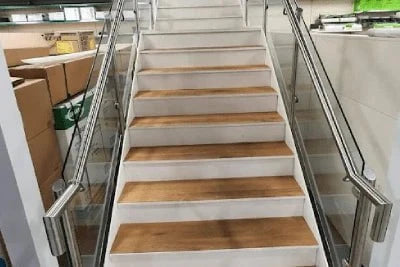
Top tips for unveiling new space in your warehouse
With a critical shortage of warehouse space in the UK, so much so national media reports have suggested Britain could run out of space entirely within a year, it is no surprise builders’ merchants are struggling to find new sites.
Whereas the big boys have the might to buy up smaller players in the market to realise extra space, or simply commission new builds, the situation threatens to stem the growth of the smaller to medium-sized merchants.
According to Paul Taylor, however, managing director of design, fit out and racking specialist Filstorage, the secret to expansion is realising more space in your existing premises.
And whereas this might sound like obvious advice it is rarely acted upon, Paul said. Yet with a little design expertise, significant extra space can often be found, and that can be the difference between ongoing growth and plateauing.
“One of the things we often come up against is the belief by the merchant they are making good use of their existing space and playing with that will be disruptive for little or no gain,” Paul said.
“But this is very often not the case. When merchants see modern products that facilitate efficient product storage, and how extra square footage can be added to a building, they soon begin to change their minds.
“Essentially, looking at improving inventory storage and management should form part of normal future planning because without the ability to move, streamlining these processes is one of the few ways of facilitating growth.”
Smaller merchants
Paul added this is particularly an issue for smaller merchants that are new to the market.
Often, he said, their focus when starting out is on shifting product and all thoughts of layout and space are a long way down the list of priorities.
“This is entirely understandable,” Paul said.
“But it can store up problems for the future.
“Big merchants have a much better handle on this. They’ve learned from experience that effective, interconnected layouts for the trade counter, shop, warehouse, and yard make for the best use of space, a better customer experience, less accidents, and fewer damaged products.
“They also build future flexibility into designs, knowing that as new branches mature, they will need to change things around.
“The smaller and middle-tier independents could learn a lot from this approach.”
Top tips for realising more space
So, with that in mind, how can merchants set about finding more space in their already busy operations? Here are Paul’s top tips for discovering those hidden extra square feet that could make all the difference.
- Consider a full redesign
When was the last time you had your branch layout looked at by an expert? For some merchants, the answer to this is never. But this is one of the most effective ways of finding significant extra space. An experienced designer will be able to see past what the depot looks like in its current state to its full potential and will have the skills and knowledge to help you realise that.

Book a free sit visit with filstorage here
- Fit a mezzanine floor
Few things have the potential to increase the overall square footage of your premises than a mezzanine floor. Sales of these have exploded in recent years as the warehousing crisis has deepened and for a range of reason. Chief among these is that they are very cost effective and very operationally effective.

Find out more about mezzanine floors
- Rack-supported mezzanine
Like conventional mezzanine flooring, rack-support flooring is an effective way to realise more storage space in your warehouse. Often sat on top of sturdy pallet racking, this prevents bulky, heavy items from cluttering up the floor.
Pigeonhole racking is also a popular option under a rack-supported mezzanine, to store long lengths of timber or drainage pipes.

Filstorage Rack Supported Floors
- Look to the heavens
Okay, so we’re not talking about seeking divine inspiration here – although after years of recession, Brexit, and now COVID to contend with, some might be tempted to do so – more that expansion with such a dearth of warehouse space on the market has become a vertical game.
This has prompted a huge demand for new racking systems that reach higher and open up the top third of a warehouse to store more product. Flexibility is the name of the game too, with racking systems needing to be quick to assemble and take down, to facilitate new configurations as product ranges evolve.
Added to this, consider forklift access. Making isles wide enough to accommodate a forklift truck will make accessing the higher aspects of your racking much easier.

Take a look at the different types of racking we can supply
- Plan the external layout as well as the internal
Efficient use of space isn’t just about how much product your warehouse can store and how easy that is to access. It is about ensuring customers can seamlessly access and move through your site without blockages, delays and having to carry out half a dozen three-point turns.
Consider this as if you were a customer yourself and make the experience as pleasant as possible. That way, you’ll ensure you have plenty to customers to buy all the extra products you can fit in your newly designed warehouse.

Paul added that by following these principles, merchants could unlock a surprising amount of space.
“It’s not uncommon to add up to 80 per cent extra more square footage to a warehouse by carrying out a complete redesign and adding in mezzanine floors,” he said.
“Rather than seeing that as a disruption and a cost, merchants should see it as an investment which will power their future growth.
“With the drastic shortage of warehousing currently available, it might even be their only path to achieving the growth they want.”
As featured in Builders Merchant News February Edition (page 33)






